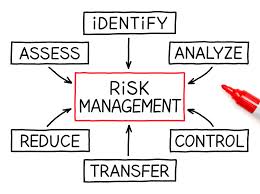
Risk Reduction in IT Solutions
Risk management is the identification, assessment, and prioritization of risks (defined in ISO 31000 as the effect of uncertainty on objectives) followed by coordinated and economical application of resources to minimize, monitor, and control the probability and/or impact of unfortunate events[1] or to maximize the realization of opportunities. Risk management’s objective is to assure uncertainty does not deviate the endeavor from the business goals.[2]
Risks can come from different ways e.g. uncertainty in financial markets, threats from project failures (at any phase in design, development, production, or sustainment life-cycles), legal liabilities, credit risk, accidents,natural causes and disasters as well as deliberate attack from an adversary, or events of uncertain or unpredictable root-cause. There are two types of events i.e. negative events can be classified as risks while positive events are classified as opportunities. Several risk management standards have been developed including the Project Management Institute, the National Institute of Standards and Technology, actuarial societies, and ISO standards.[3][4] Methods, definitions and goals vary widely according to whether the risk management method is in the context of project management, security, engineering, industrial processes, financial portfolios, actuarial assessments, or public health and safety.
Risk sources are more often identified and located not only in infrastructural or technological assets and tangible variables, but in Human Factor variables, Mental States and Decision Making. The interaction between Human Factors and tangible aspects of risk, highlights the need to focus closely into Human Factor as one of the main drivers for Risk Management, a "Change Driver" that comes first of all from the need to know how humans perform in challenging environments and in face of risks (Trevisani, 2007). As the author describes, «it is an extremely hard task to be able to apply an objective and systematic self-observation, and to make a clear and decisive step from the level of the mere "sensation" that something is going wrong, to the clear understanding of how, when and where to act. The truth of a problem or risk is often obfuscated by wrong or incomplete analyses, fake targets, perceptual illusions, unclear focusing, altered mental states, and lack of good communication and confrontation of risk management solutions with reliable partners. This makes the Human Factor aspect of Risk Management sometimes heavier than its tangible and technological counterpart»[5]
The strategies to manage threats (uncertainties with negative consequences) typically include transferring the threat to another party, avoiding the threat, reducing the negative effect or probability of the threat, or even accepting some or all of the potential or actual consequences of a particular threat, and the opposites for opportunities (uncertain future states with benefits).
Certain aspects of many of the risk management standards have come under criticism for having no measurable improvement on risk, whether the confidence in estimates and decisions seem to increase.[1] For example, it has been shown that one in six IT projects experience cost overruns of 200% on average, and schedule overruns of 70%.[6]
Please contact us for details. One of our engineers will be happy to discuss your requirements.